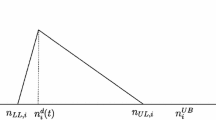Abstract
Human resource is one of the most effective resources in the development of any organization or a Nation. Optimal utilization of manpower is a pivotal challenge to a manager of a dynamic management system. Achieving the objectives by meeting the constraints on various feasibilities is the core problem before statisticians, model developers and OR scientists. In this paper we develop a model with Stochastic Programming Problem of manpower recruitment for an organization where the graded manpower system is observed. The averages, variance of number of employees in initial and final grades before leaving/resigning organization are computed by a suitable bivariate probability mass function. The costs like setup cost, recruitment cost, salaries, Cost of Training, Promotion Costs etc., are considered while developing a model. Sensitivity analysis was also carried out and observed the model behaviour. This model is a suitable tool to serve the decision maker for making optimal decisions on Recruitment policies for determining the optimal recruitment cost, to decide number of employees to be recruited through various grades, to estimate the number of employees for Promotion and to Retirement etc.
Similar content being viewed by others

References
Chattopadhyay et al (2007) A stochastic manpower planning model under varying class sizes. Ann Oper Res 155:41–49
Dill WR, Gawer DP, Weber WL (1966) Models and modeling for manpower planning. Manag Sci 13(4):B142–B167
Gary L et al (1975) A model for manpower management. Manag Sci 21(12)
Ginsberg RB (1971) Semi-Markov process and mobility. J Math Sociol 1:233–262
Glen JJ (1977) Length of service distributions in markov manpower models. Oper Res Q 28:975–982
Jeeva M et al (2004) An application of stochastic programming with Weibull distribution–cluster based optimum allocation of recruitment in manpower planning. Stoch Anal Appl 22(3):801–812
Jewelt RJ (1967) A minimum risk manpower schedule technique. Manag Sci 13(10):B578–B592
Kareem B, Aderoba AA (2008) Linear programming based effective maintenance and manpower planning strategy: a case study. J Comput Internet Manag 16(2):26–34
Srinivasa Rao K, Srinivasa Rao V, Vivenkanada Murty M (2006) On two graded manpower planning model. Opsearch 43(3):225–237
Taiwo AS (2007) Determination of the optimal manpower size using linear programming model. Res J Bus Manag 1(1):30–36
Vajda S (1985) The use of linear programming in manpower planning; Homenaje Al Profesor Sixto Rios Trabajos De Estadistica De Investigacion Operativa 36(3):301–311
Yadavalli VSS, Natarajan R (2001) A semi-Markov modelo f manpower system. Stoch Anal Appl 19(6):1077–1086
Yadavalli VSS, Natarajan R, Udayabhaskaran S (2002) Time dependent behaviour of Stochastic models of manpower system—impact of pressure on promotion. Stoch Anal Appl 20(4):863–882
Yadavalli VSS, Setlhare K, Mishra SS, Rajalakshmi R (2006) An analysis of an optimal promotion policy for a manpower system using a queuing approach. Manag Dyn. http://findarticles.com/p/articles/mi_qa5465/is_200604/ai_n21402995/
Author information
Authors and Affiliations
Corresponding author
Appendices
Appendix 1
See Table 1.
Appendix 2
2.1 Inputs of manpower requirements
2.2 Inputs of decision parameters
2.3 Inputs of manpower requirements
2.4 Inputs of decision parameters
Rights and permissions
About this article
Cite this article
Rao, P.T., Reddy, P.R.S. & Suhasini, A.V.S. Optimal manpower recruitment by stochastic programming in graded manpower systems. Int J Syst Assur Eng Manag 1, 178–185 (2010). https://doi.org/10.1007/s13198-010-0016-7
Received:
Revised:
Published:
Issue Date:
DOI: https://doi.org/10.1007/s13198-010-0016-7













